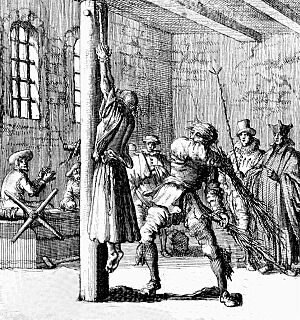Anabaptist facts for kids
Anabaptists are Protestant Christians. The word "Anabaptist" comes from the Greek language, meaning "to baptize again." This is because followers of these groups believe that people should be baptized only after they have chosen to believe in Jesus. This is called "believer's baptism." They believe that babies cannot truly choose their faith, so infant baptism is not valid for them.
The Anabaptist movement began in 16th century Europe as part of the "Radical Reformation." This was a time when many people were questioning traditional church practices. Today, the most well-known Anabaptist groups are the Mennonites, the Amish, and the Hutterites.
Contents
The Anabaptist Movement
A New Idea of Baptism
The Anabaptists were different from other Christian groups because of their strong belief in "believer's baptism." They felt that baptism should be a choice made by someone who understands and believes in their faith. This was a big change from the common practice of baptizing babies. Because of this belief, people who had been baptized as infants and then joined the Anabaptists were "re-baptized" as adults. This is how they got the name "Anabaptists," meaning "those who baptize again."
Roots in the Reformation
The Anabaptist movement started during the Protestant Reformation, a major religious change in the 1500s. While leaders like Martin Luther and John Calvin were reforming the church, some people felt they didn't go far enough. These "Radical Reformers" wanted even bigger changes. They believed the church should be completely separate from government and that Christians should live very simply, following the teachings of the Bible closely. The first Anabaptist groups appeared in Switzerland in 1525.
Who Are Anabaptists Today?
Mennonites: A Peaceful Path
The Mennonites are one of the largest Anabaptist groups today. They are named after Menno Simons, a Dutch priest who joined the Anabaptist movement in the 1530s. Mennonites are known for their commitment to peace and non-violence. They believe in living simply and helping others. Many Mennonites are involved in relief work around the world. There are different kinds of Mennonites, some who live very traditionally and others who have adopted more modern ways of life.
Amish: Simple Living
The Amish are another well-known Anabaptist group. They originated from a split within the Mennonite community in the late 1600s. The Amish are famous for their plain clothing and for often choosing to live without modern technologies like cars, electricity, and telephones. They focus on strong family ties, farming, and living apart from the wider world. Their goal is to live a life dedicated to God, free from worldly distractions.
Hutterites: Community Life
Hutterites are an Anabaptist group that lives in communities called "colonies." They share all their property and resources, living a communal life based on early Christian practices. Hutterites are known for their farming and manufacturing skills. They also emphasize education and raising their children within their close-knit communities.
Important Beliefs
Believer's Baptism
As mentioned, the central belief for Anabaptists is that baptism should only happen when a person is old enough to understand and choose their faith. They see baptism as a public promise to follow Jesus. This is why they do not baptize infants.
Living a Peaceful Life
Many Anabaptist groups strongly believe in non-resistance, also known as pacifism. This means they refuse to use violence, even in self-defense or war. They believe that Christians should follow Jesus's teachings of love and forgiveness, even towards enemies. This belief has often led them to face challenges, especially during times of conflict.
Separation from the World
Anabaptists often believe in living "separate from the world." This means they try to avoid things they see as negative influences from society. For some groups, this means dressing plainly, not using certain technologies, or not participating in politics. The goal is to live a life focused on their faith and community, rather than on worldly possessions or power.
Challenges and Persecution
Because of their unique beliefs, Anabaptists faced many difficulties in the 16th century. Their refusal to baptize infants, swear oaths, or serve in the military was seen as a threat by both Catholic and Protestant leaders. Many Anabaptists were persecuted and even lost their lives for their faith. Despite these challenges, the movement survived and grew, with its followers eventually finding places where they could practice their beliefs more freely.
Images for kids
-
Dissatisfaction with the outcome of a disputation in 1525 prompted Swiss Brethren to part ways with Huldrych Zwingli.
-
Thomas Müntzer led the German peasants against the landowners
-
Memorial plate at Schipfe quarter in Zürich for the Anabaptists executed in the early 16th century by the Zürich city government
-
Evangelical Mennonite Church in Altkirch, Association of Evangelical Mennonite Churches of France.
-
Goshen College Library in Goshen, Indiana, Mennonite Church USA.
See also
 In Spanish: Anabaptismo para niños
In Spanish: Anabaptismo para niños













